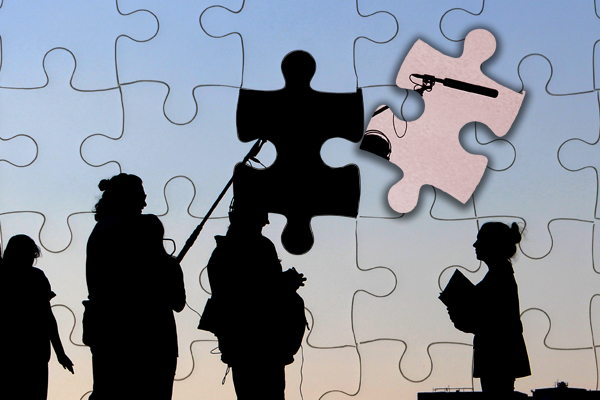Don’t Forget the Audio Guy!
An indie film producer sends you something they worked on and they ask you to watch it. You do so with a bit of hesitance.
The opening credits play overtop a musical score. The shots look really nice. There are some interesting transitions. You think, ‘hey, maybe this is a really professional video.’ Then, the first scene begins, and the dialogue audio fades up to full volume. You can hear a loud room hum, completely distracting you from everything you see on screen. The first character begins speaking. Every environmental noise around them fills underneath, as a bed to their dialogue. Then, suddenly, it cuts to a second shot with a different character, and the room hum is gone! Then, it cuts back to the first shot, and there it is again! Then, woah! It cuts to the wide shot, and it sounds like both characters are in a large tin can. The illusion of the cut being a live, seamless stream of action is gone. You can see the man behind the curtain, and he is not an audio guy.
Today, almost anyone can capture a really nice, professional looking piece of video – even if just for one shot, and even if by accident. The majority of us are walking around with a pretty powerful camera in our pockets at all times, with the ability to shoot in 4K or in slow-motion. Semi-professional, or ‘pro-sumer’, cameras have come down in price drastically in the past few years. Those things have given a lot of indie filmmakers and video creators a chance to produce their own high-quality images for little cost; however, the visual is only part of the equation.
There are, of course, many factors that go into a professional product: the story (as we often boast), the cinematography, the lighting, the acting, the musical score, the editing…and the often-overlooked but crucial aspect, the audio. I’ve worked with some really talented audio professionals over the years who taught me so much about the medium. And yet, I probably still don’t know half of what they know. That’s why one of my first considerations in assembling a production crew is always the “audio guy” (or gal). Audio design is AS important as visual design in each project. You’re telling a story – not just with moving pictures, but also with sound, dialogue, tones and music. Would you shoot a whole scene with the lens cap still on? I doubt it. But, I’ve watched many, many indie or amateur productions where they decided the on-board camera mic was good enough for their grand venture.
I’m writing this shortly after “Bohemian Rhapsody” won two Oscars for its audio production: one for Sound Mixing and one for Sound Editing. Regardless of how you feel about the winners, losers, snubs, and snobs from this year’s Awards, I think “Bohemian Rhapsody” is a perfect example for this blog. The filmmakers focused as much on the audio design as they did all other aspects of the film. They told a story that you could close your eyes and listen to, regardless of what was displayed on the screen. Freddie Mercury and Queen were famous for their experimental sound, track over-dubbing and mixing. They played with everything stereo and reel-to-reel had to offer in their time; and that’s all on top of how they constantly reinvented their music over the course of their run. “Bohemian Rhapsody” did a great job of working those things into the design of the film and making them organic, seamless and part of the overall tone. That’s what audio should be to all productions. Audiences typically don’t notice really good audio. Everyone notices really bad audio.
If you’re just starting out, or maybe looking to do some commercial work for your business, here are some tips:
- When you location scout, listen for room tone, environmental noise, echo issues, etc.
- Before you pack your gear, figure out HOW you want to mic the shots – is it possible to boom it? Can you use a plant mic? Can you hide a lavalier on one of the actors? Maybe all 3?
- Your sound should be consistent. The different characters should be mic’d in similar ways and with similar gear. Without going into the technical nitty-gritty, you don’t want to do things like boom one person from above in some shots, and then from below in others if they’re picking up different tones/sounds in the room. Don’t switch from lav to boom for various shots – the sound will likely be noticeably different.
- Always collect ambient noise, aka room tone. You can use this as a constant bed under the dialogue in case there are inconsistencies.
- Use smooth fades in your audio edits (where possible), so you don’t have a jarring cut from clip to clip.
And, perhaps most importantly, don’t forget the audio guy! You’re concerned with the visual story and countless other details. You need someone to handle the audio. You can’t do it all, and you need to empower people on the team to handle different jobs. Your audio engineer is as important as the camera guy and actors. Do it right, and you won’t have to revert to ADR down the road (voice-dubbing), which is a nightmare…and a whole other blog post!
